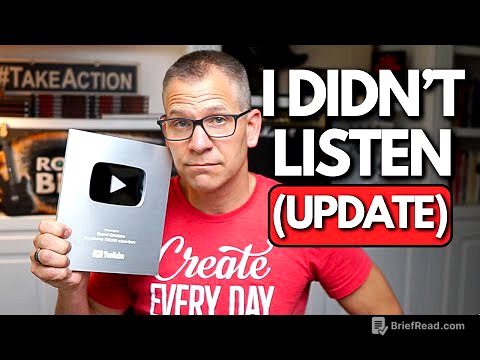TLDR;
This video discusses seven common storytelling mistakes that beginner content creators make and provides actionable strategies to improve content performance. It emphasizes adapting to modern attention spans, structuring intros effectively, and using techniques to keep viewers engaged. The video also covers the importance of character development, shareability, and visual aids in storytelling.
- The traditional story arc is outdated for online content due to time compression.
- Intros should prioritize "what" and "why" before "who," "how," "when," and "where."
- Re-hooking viewers throughout the video is crucial for maintaining attention.
- Incorporating a villain and a relatable hero enhances audience engagement.
- Atomic sharability, or condensing stories into easily shareable units, is key for virality.
- Visual aids are essential for comprehension and engagement.
Intro [0:00]
The video introduces the topic of storytelling and its importance in improving content performance. It highlights that even small adjustments to storytelling techniques can lead to significant improvements in content engagement. The video promises to break down seven common storytelling mistakes to avoid, aiming to change the viewer's perspective on storytelling.
The Traditional Story Arc Is A Lie [0:27]
The traditional story arc, with its slow build-up of background, conflict, rising action, climax, falling action, and resolution, is no longer effective in the internet era due to time compression. People's attention spans have shortened, making the traditional arc too slow to hold interest. The modern story arc starts with an intense hook around 70 out of 100, quickly introducing conflict to spike intensity to 90 out of 100 within the first minute or two. Tension is then released, followed by subsequent peaks and releases every 2 to 5 minutes. This approach requires a strong intro to hook viewers immediately, earlier conflict, and more frequent peaks to maintain attention.
Jumbling The W’s [4:30]
Beginner storytellers often build intros in the wrong order by prioritizing "where" and "when" before "who," "what," "why," and "how." The modern hook should start with "what" is happening and "why" it matters to the viewer, followed by "who" it's for and "how" the information is credible. Personal details like "where" and "when" should be added as color. This approach ensures viewers understand the stakes and relevance of the story immediately, preventing them from losing interest.
Rebuys & Rehooking [7:13]
After initially hooking the viewer, it's important to keep them engaged by re-hooking them throughout the video. This involves teeing up new stakes or reintroducing a new pain point after solving the first one. By closing existing loops and opening new ones, creators can maintain viewer attention and increase average view duration, which is crucial for social algorithms.
Heroes vs Villains [9:46]
Stories benefit from contrast, making the inclusion of a villain essential. The villain doesn't necessarily need to be a character but can be a concept, group, or brand that opposes the hero. This contrast creates a bigger distance between the hero and villain, making the story more compelling.
Nobody To Root For [10:30]
Stories are more engaging when viewers have someone or something to root for. Making the hero likable and the situation relatable encourages viewers to invest in the story. By building common ground and contextualizing the story's relevance to the target viewer, creators can increase audience investment and optimism.
Atomic Shareability [11:24]
Atomic sharability refers to the ability to condense a story or idea into a single, easily shareable unit. This involves cutting unnecessary fluff, using simple words and punchy sentences, and telling stories in a way that others can easily retell. To achieve this, explain complex topics twice: once in technical terms and again using a metaphor to ensure easy understanding and sharing.
Painting The Picture [12:35]
Visuals are crucial for helping viewers absorb information. If visuals are not available, creators must paint a vivid picture with words. However, using video visuals is more effective because the human brain is designed for visual input, making it easier to convey the message and maintain viewer engagement.









